President Eisgruber’s annual State of the University letter, 2020
Princeton University President Christopher L. Eisgruber sent his annual State of the University letter to faculty, students and staff on Monday, Feb. 3, highlighting recent developments at Princeton and identifying future goals.
Eisgruber will summarize his fourth annual letter and invite questions at two town hall meetings:
• The Council of the Princeton University Community (CPUC) meeting from 4:30 p.m. to 6 p.m. Monday, Feb. 10, in the Frist Campus Center Multipurpose Room.
• A town hall for employees from 10 a.m. to 11 a.m. Tuesday, Feb. 25, in Richardson Auditorium in Alexander Hall. The University will provide employees with paid release time so they can attend this meeting during normal work hours, subject to supervisory approval in order to maintain normal operations. Shuttles will be provided to and from the event for employees based at 701 Carnegie Center and 100 Overlook Center who wish to attend.
President’s Letter
The State of the University, February 2020
Christopher L. Eisgruber
When the Nobel Prize committee honors a Princeton faculty member, it provides our community with a special opportunity to rejoice and celebrate not only the laureate’s achievements but also the values and qualities that define us as a University.
That was very much the case when Professor P. James E. Peebles *62 won the physics prize last October. As a cosmologist, Peebles embodies Princeton’s commitments to scholarly excellence and curiosity-driven research. As a product of our Graduate School, he demonstrates the kind of impact that we hope our alumni will have. And as an outstanding mentor to hundreds of graduate students and undergraduates (including this writer!), he exemplifies Princeton’s distinctive synergy between world-class research and spectacular teaching.
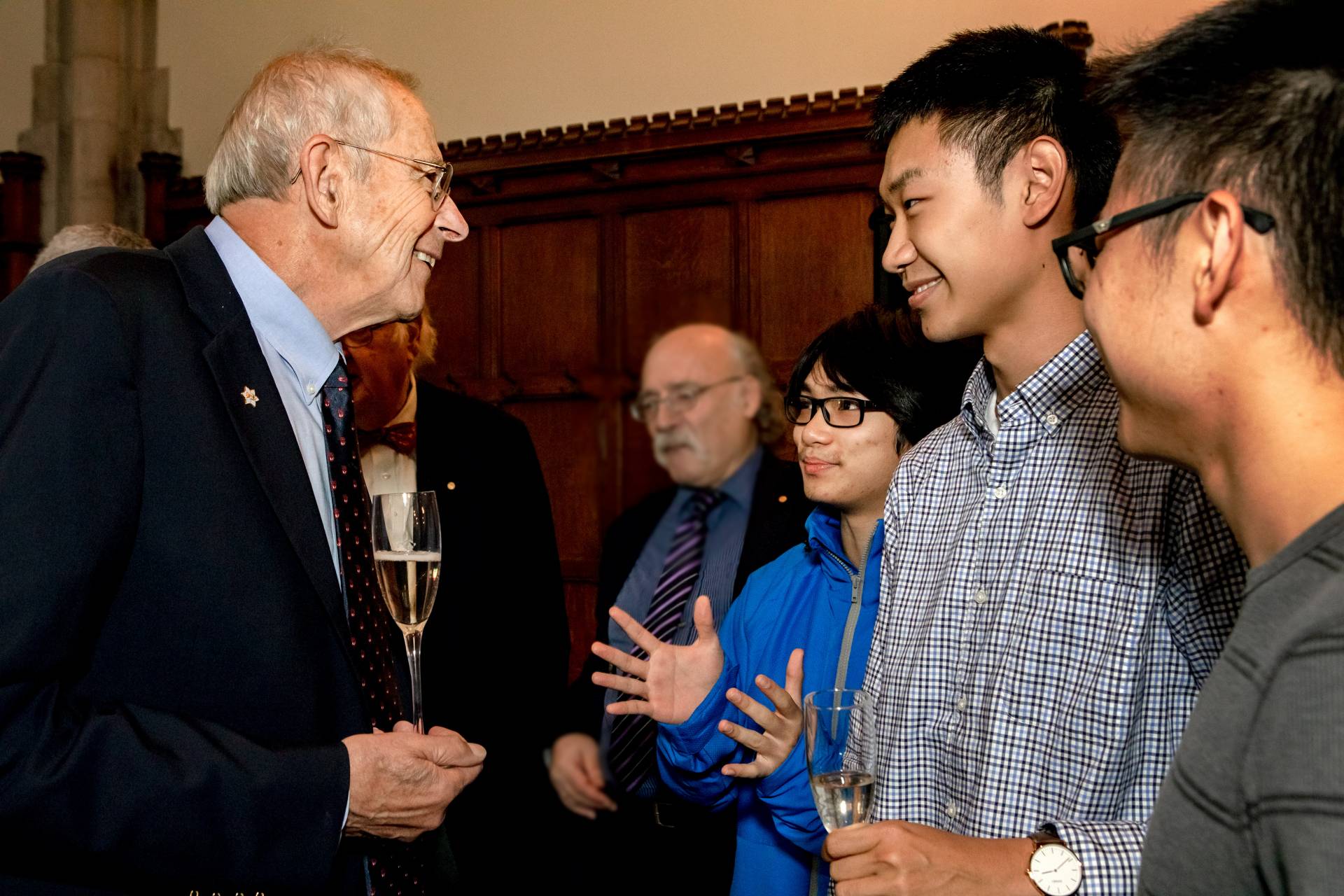
Princeton Professor P. James E. Peebles (left) chats with students after winning the Nobel Prize in Physics on Oct. 8, 2019. Peebles received his Ph.D. from Princeton in 1962 and exemplifies the University’s long tradition of excellence in theoretical physics. Professor Duncan Haldane (second from left), was the 2016 Nobel laureate in physics.
The award was also an occasion to reflect on Princeton’s long tradition of excellence in theoretical physics, which has flourished here at least since the arrival of Albert Einstein, John von Neumann, Eugene P. Wigner, and other Jewish émigrés in the 1930s. How those scholars came to Princeton, a university that then had a reputation for being unfriendly to Jews, is a remarkable story. It is also a story that ties directly to the state of the University today and provides insights and lessons for the path that lies ahead.
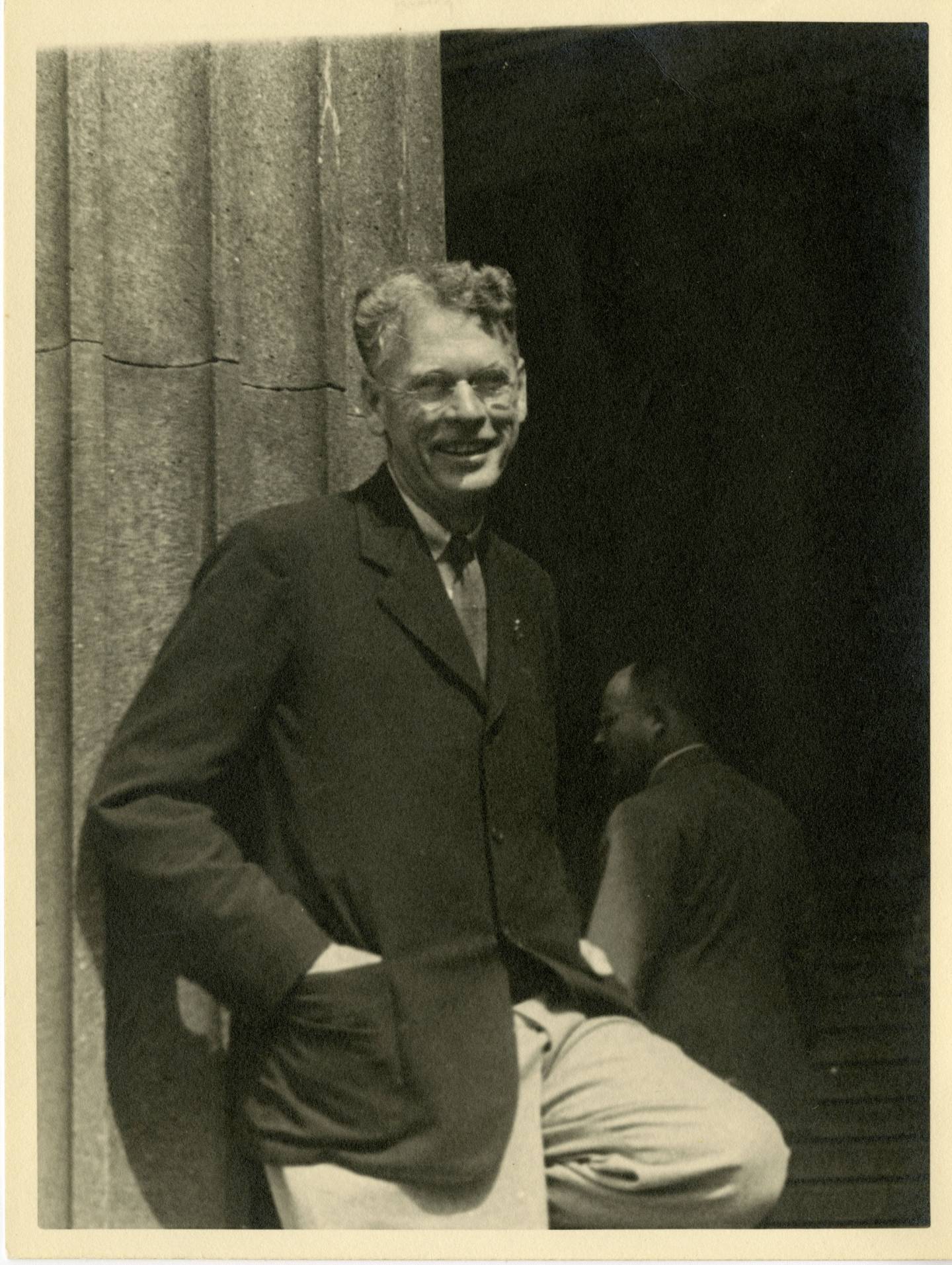
Oswald Veblen, the influential Princeton University mathematician, was one of the first faculty at the Institute for Advanced Study in Princeton.
As Elyse Graham ’07 documented in a marvelous Princeton Alumni Weekly (PAW) article, Professor Oswald Veblen, a Princeton mathematician, played a critical role in rescuing Jewish scholars from persecution in Europe. Veblen worked with the Emergency Committee in Aid of Displaced German Scholars to accommodate refugees at Princeton and elsewhere in the country. The scholars whom Veblen helped bring to Princeton included professors of mathematics, physics, economics, and art history.
Some who came to Princeton, including Einstein himself, had appointments at the Institute for Advanced Study rather than at the University. Here, too, Veblen’s contributions were pivotal. He influenced Abraham Flexner’s decision to found the Institute in Princeton rather than Newark, as Flexner’s donors would have preferred. The newly formed Institute was more inclusive than the University. It appointed the female mathematician Emmy Noether as a visiting scholar and offered a position to the black mathematician William Claytor, whom the University had declined to accept when Veblen proposed that he be given an office there.
Last but not least, Veblen led the design of the first Fine Hall, which we know today as Jones Hall. At a time when many Princeton professors had no offices and worked from home, Veblen imagined something novel: a building dedicated to mathematics and designed to generate intellectual community and exchange. The plan for Fine Hall even included bathing facilities so that professors could shower after playing tennis on the nearby courts. Amused undergraduates credited this feature to Dean Luther Eisenhart and mocked it in song:
He’s built a country-club for Math
Where you can even take a bath
Veblen’s project succeeded splendidly. From 1933 to 1939, Fine Hall housed the University’s and also the Institute’s faculty, making it perhaps the world’s most extraordinary gathering place for mathematicians and theoretical physicists. Others—including Professor John Archibald Wheeler and graduate student Richard Feynman *42, both of whom Wigner helped to attract—followed and added to Princeton’s reputation as a research powerhouse.
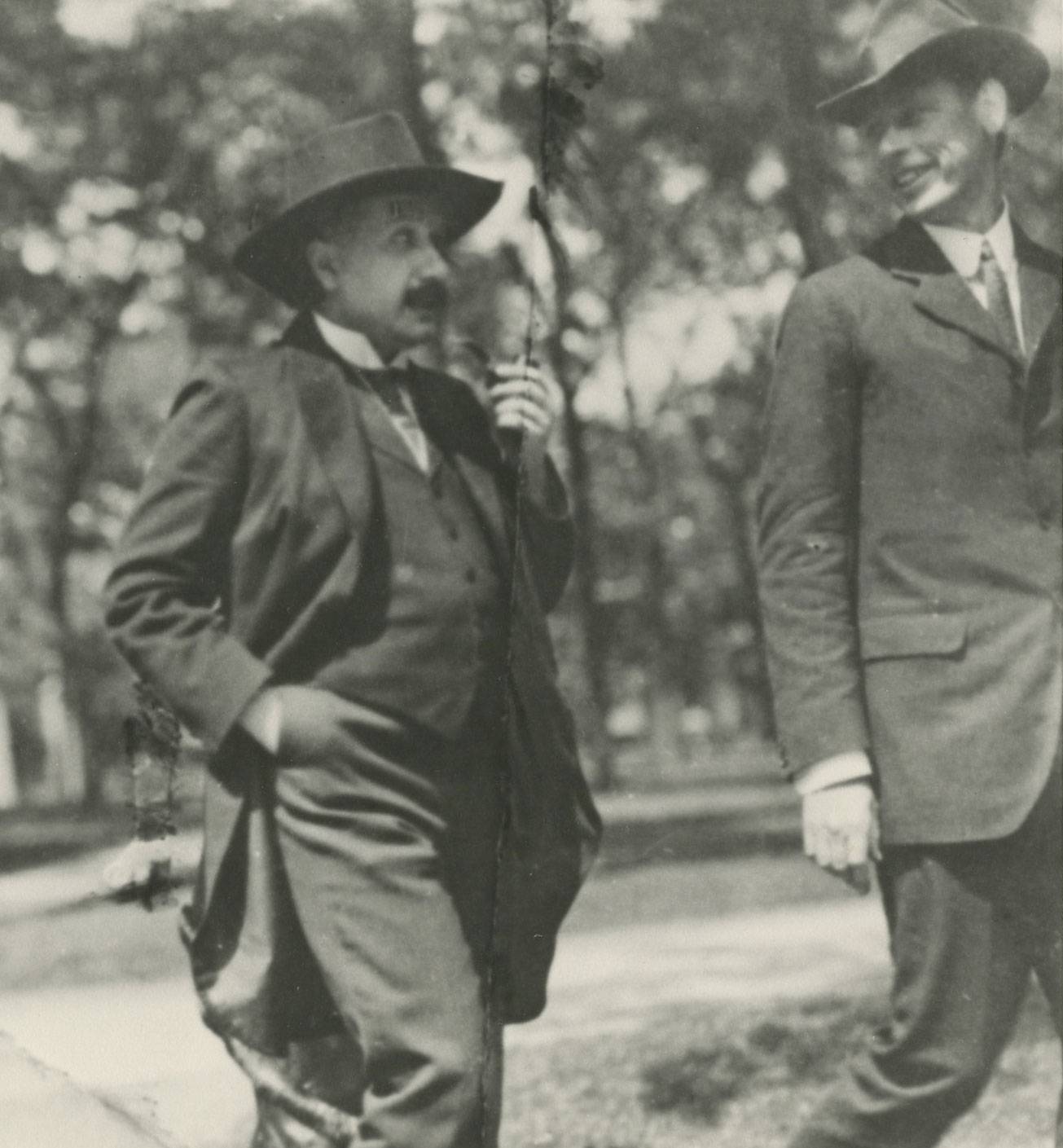
Albert Einstein and Oswald Veblen in Princeton in 1921. Einstein moved to Princeton in 1933.
In 2020, when the world is experiencing a disturbing surge of anti-Semitism and the United States is closing its doors to refugees, Veblen’s humanitarian courage is especially inspiring. Graham points out in another PAW article that an eminent Harvard professor opposed Veblen’s efforts, arguing that if refugees were accommodated, “the number of similar positions available for young American mathematicians is certain to be lessened, with the attendant probability that some of them will be forced to become ‘hewers of wood and drawers of water.’”
Veblen persisted, to the great benefit of this University and our country. We need to remember today the lessons he taught ninety years ago. Our University and our country succeed best when they are open to honest, hard-working people from all backgrounds, regardless of status or national origin.
I am accordingly troubled by how tensions in U.S.-China relations might damage America’s research community. The American government is rightly concerned about China’s efforts to steal intellectual property and research discoveries from American universities and businesses. The threat from Chinese espionage is real and substantial; universities, including Princeton, must take care to educate their scholars about these risks, to avoid inappropriate foreign influence, and to identify and address misconduct when it occurs.
Racial and national stereotypes, however, are no more acceptable in this domain than in any other, and do not reflect the community we strive to build at Princeton. Such stereotyping inevitably leads to injustice. Law-abiding Chinese and Chinese-American scholars now worry about being targeted for “researching while Chinese.”
As Oswald Veblen recognized nearly a century ago, America’s innovation, creativity, and excellence all benefit tremendously from infusions of talent from throughout the world. If we are concerned about competition from China, the solution is to invest aggressively in American research and innovation, not to close the country’s doors to immigrants. The vitality of this and other great American universities will depend on our continued ability to attract, welcome, and support outstanding students and researchers from every part of the globe and every sector of society.
This University has advocated vigorously for policies that permit and facilitate the free flow of talent—talent of the kind that fortified America in the past and that will be essential to its future. In November, I traveled to the Supreme Court to join Princeton’s co-plaintiffs, María Perales Sánchez ’18 and Microsoft president Brad Smith ’81, for the oral argument in our suit challenging the government’s attempt to rescind the Deferred Action for Childhood Arrivals (DACA) program.
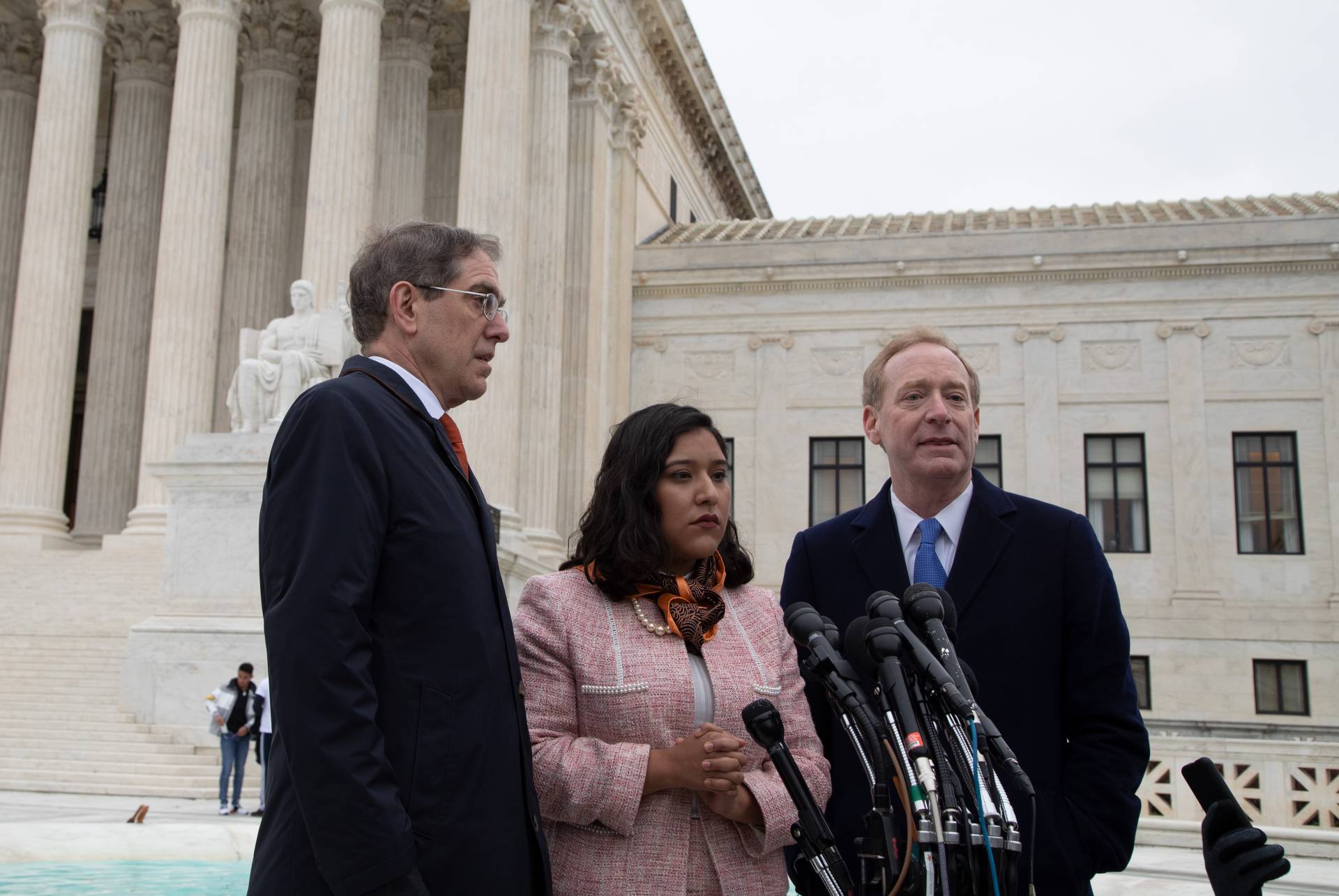
Princeton President Christopher L. Eisgruber, Princeton alumna María Perales Sánchez and Microsoft President and University Trustee Brad Smith gather on the steps of the U.S. Supreme Court on Nov. 12, 2019, after attending oral arguments on challenges to the termination of the DACA program.
The refugees whom Veblen aided had no home to which they could return; our DACA students have no other home at all. They have grown up in the United States, and they contribute vibrantly to our community. The Supreme Court is likely to render a decision by the end of June. Whatever happens in that case, we will continue to press Congress to create a path to citizenship for these honest, hard-working people who have so much to offer our campus and our country.
We will also continue our efforts to ensure that every member of our campus community is respected and capable of participating fully in the life of the University. Diversity and inclusivity are essential to the achievement of excellence and central to our mission. One of the highlights of my fall semester was Thrive: Empowering and Celebrating Princeton’s Black Alumni, a conference that brought nearly 1,300 alumni and guests to the Princeton campus. As I listened to black alumni talk about their experiences during their time on campus and afterward, I was moved by their strength and vision.
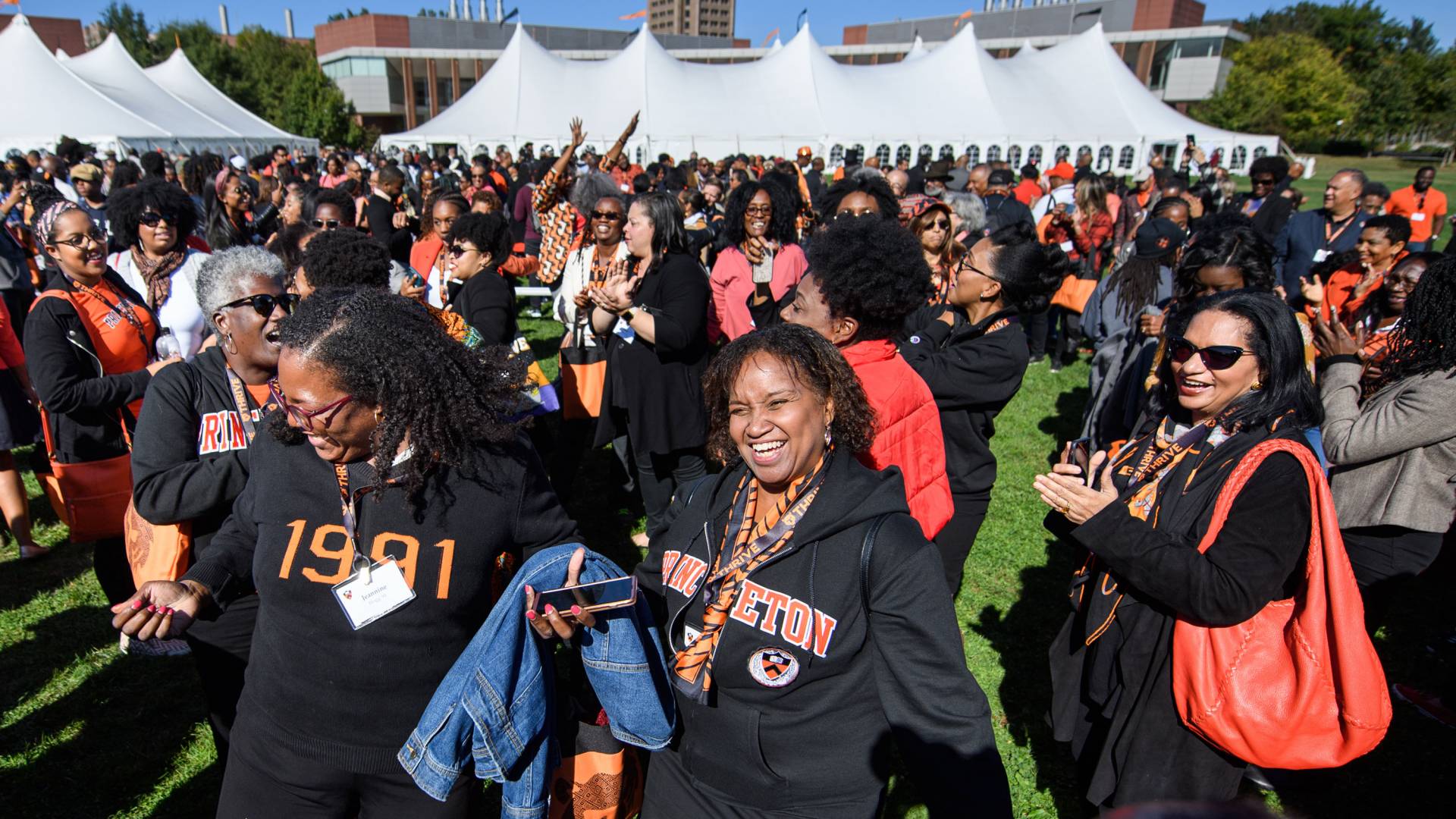
Nearly 1,300 Princeton alumni and guests came to campus Thursday through Saturday, Oct. 3-5, 2019, for “Thrive: Empowering and Celebrating Princeton’s Black Alumni.” The gathering featured discussions with alumni, faculty and students, networking and social opportunities, entrepreneurship workshops, performing arts showcases, and many ways to celebrate the Princeton community.
Oswald Veblen understood that people are the heart and soul of a great university, and he also understood that thoughtfully designed buildings can stimulate the collaborations, activity, insights, and friendships that animate a scholarly community. His vision for the old Fine Hall, and its timely completion, attracted brilliant thinkers to Princeton and forged a scholarly legacy that remains vibrant almost a century later.
I mention this example because we are about to embark on a new round of construction to support the teaching and research mission of this University. The projects, which emerged from the University’s strategic framework and campus planning process, are both numerous and varied: they will encompass laboratories, classrooms, student residences, faculty offices, health services, athletics, and the Art Museum.
These projects, like any major renovation or construction efforts, will produce some inconvenience while ongoing, but they will also powerfully enhance the teaching, research, and values that define Princeton. I accordingly want to share with you what to expect over the next year and beyond—both so that you will be prepared for the impending disruption, and so that you can anticipate the benefits that will follow!
We will break ground this spring on two new residential colleges, to be located south of Poe Field, where the softball field, tennis center, and soccer stadium are now located. That location, I should stress, is on the University’s historic campus north of Lake Carnegie: I occasionally encounter students or alumni who mistakenly imagine that the new residences will be across the lake. In fact, the additional colleges will be located about midway between the Princeton Neuroscience Institute and Elm Drive, across Poe Field from Butler College, with connections to the neighboring woodlands.
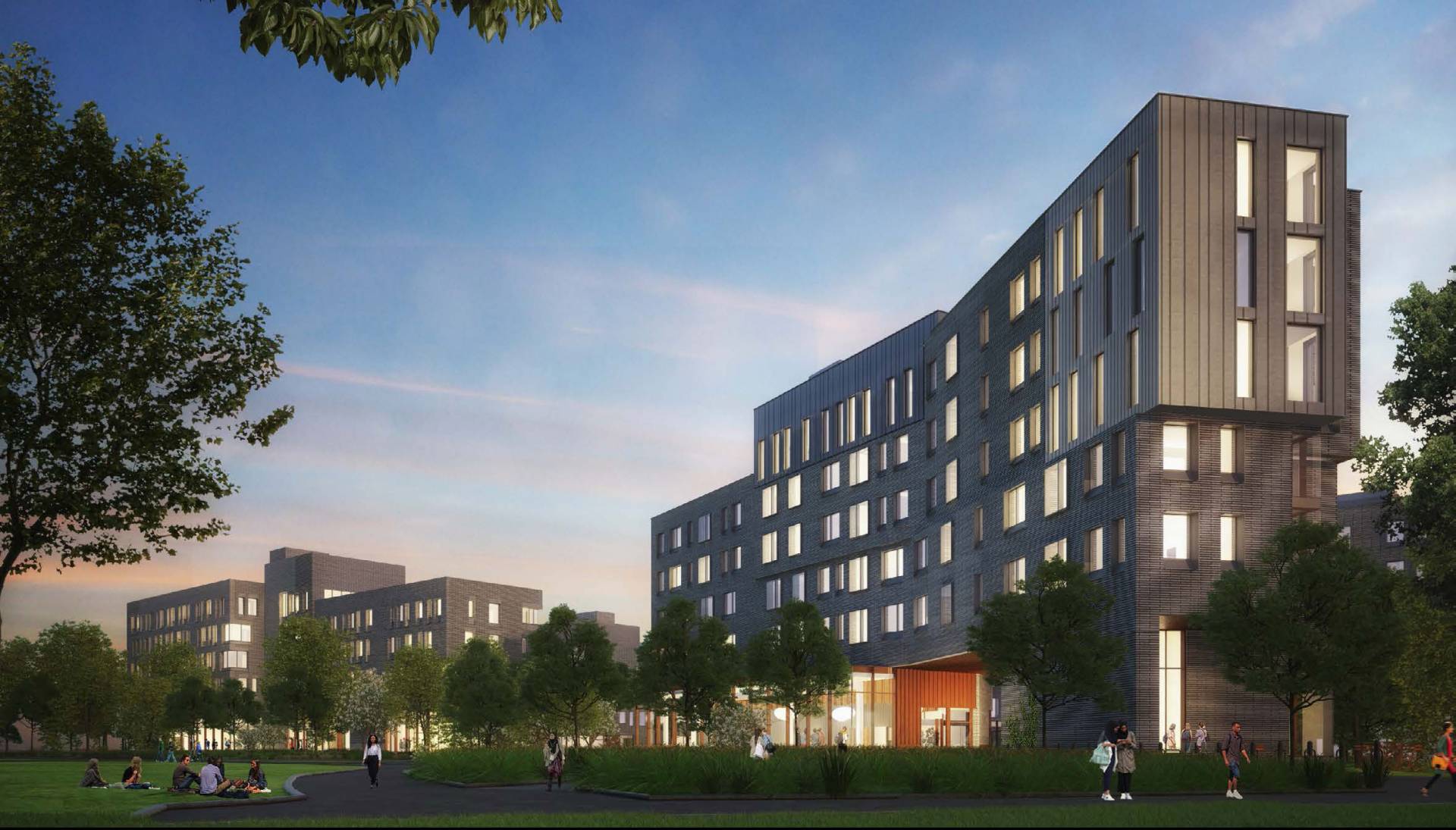
This architectural rendering shows two proposed new residential colleges, viewed from Elm Drive, for which ground will be broken in the spring.
We expect to complete the two new colleges before September 2022, in time for the beginning of the 2022-23 academic year. Perelman College and its companion college will provide roughly 1,000 beds in total. Five hundred of those beds will allow us to expand the undergraduate student body by about 10 percent (around 125 students per class year); the remainder will allow us to renovate or replace other housing stock no longer well suited to the goals of University residential life. Once the two new residential colleges are open, we will most likely begin the renovation cycle by closing Wilson College and replacing the existing facilities with new and improved ones.
The expansion of the undergraduate student body is prompting other significant enhancements to the University’s residential life facilities. To meet the demand for additional recreation and fitness space, we plan to add to and renovate a portion of Dillon Gymnasium. We will also enlarge and improve University Health Services. As I noted in last year’s letter, the health services project will accommodate not only the growth of the student body, but also the changing needs of our students and evolving models for wellness services. It will encompass a new building attached to a renovated Eno Hall. The faculty and staff in Eno will have to move to temporary quarters on their way to a new home for the environmental sciences (more on that below!), and I am grateful for their flexibility while their building is under construction.
To make room for the new residential colleges, our softball field and the Lenz Tennis Center (which will become part of a new, multi-sport racquet center) will be relocated across the lake, near our rugby field. We will construct new graduate residences nearby. These facilities will form the beginning of a Lake Campus that integrates the University’s campus-making traditions with a new and distinctive natural setting. Both the athletics facilities and the graduate residences will be supported by regular shuttle transit service.
Over the next fifteen months, we will begin work on several projects located east of the football stadium, beyond Finney and Campbell fields: a soccer practice field, the new Myslik Field and Roberts Stadium (which are being relocated to make room for Perelman College and its companion), a parking garage, and a geothermal energy plant conveniently called TIGER (for “Thermally Integrated Geo-Exchange Resource”). TIGER is an important part of the University’s Sustainability Action Plan, which aims to achieve net zero greenhouse gas emissions no later than the University’s 300th anniversary in 2046. TIGER will use geothermal wells to reduce the University’s need to purchase energy. Its construction will be part of the first phase in the eventual conversion of the entire campus from a steam heating distribution system to a far more energy-efficient hot water system.
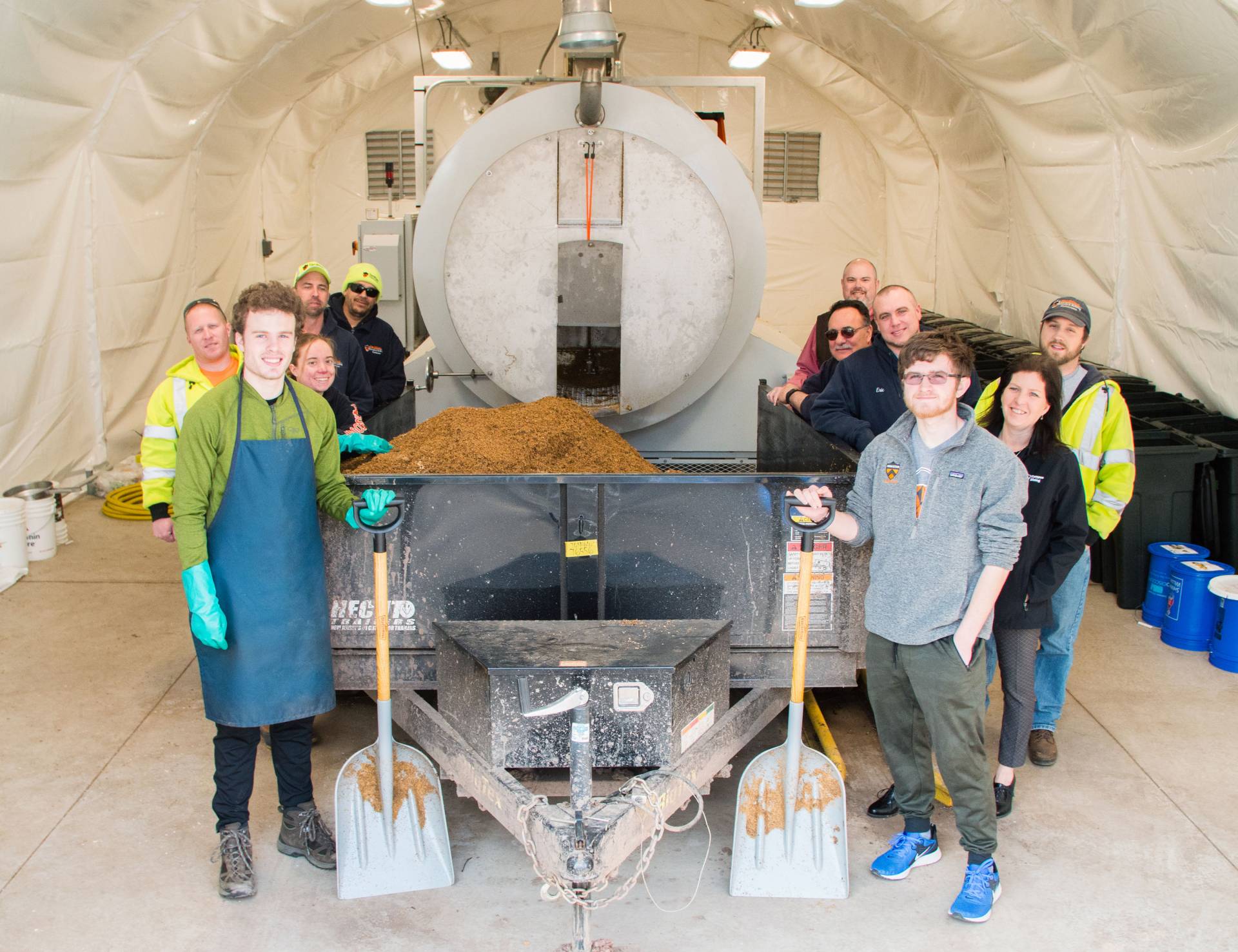
Through a partnership between Facilities and Campus Dining, the S.C.R.A.P. Lab converts food waste into nutrient-rich compost. The S.C.R.A.P. Lab is one of many projects, initiatives and programs that make up the University’s Sustainability Plan.
We expect construction of the parking facility, along with some geothermal site work, to begin this summer. The pace of summer activities, including construction projects, may seem especially rapid because this year’s summer break will, as I expect you know already, be one week shorter than usual. The University is transitioning from its old calendar to a new one that both begins and ends earlier. The first day of classes will be Wednesday, September 2, 2020, which precedes Labor Day. As I noted in last year’s letter, the new calendar, approved at a faculty meeting in April 2018, will allow us to complete fall term examinations before the winter holidays. It will also make room for an optional two-week Wintersession designed for innovative, non-graded learning and growth opportunities. Undergraduate students, graduate students, staff, and faculty will be free and encouraged to participate as teachers, learners, or both.
In the late spring of 2021, just a few months after our first Wintersession concludes, we will start construction of the new Princeton University Art Museum. During the University’s strategic planning process, the Task Force on the Future of the Humanities noted that the museum’s location at the heart of the campus “makes it an ideal ‘center’ for the exchange of ideas and the stimulation of innovative thought at Princeton,” but lamented that “the Museum’s [current] space imposes severe limits on its operations, its intellectual impact, and its ability to innovate.” The task force recommended the creation of a new “purpose-built museum facility,” and the Board of Trustees endorsed that idea.
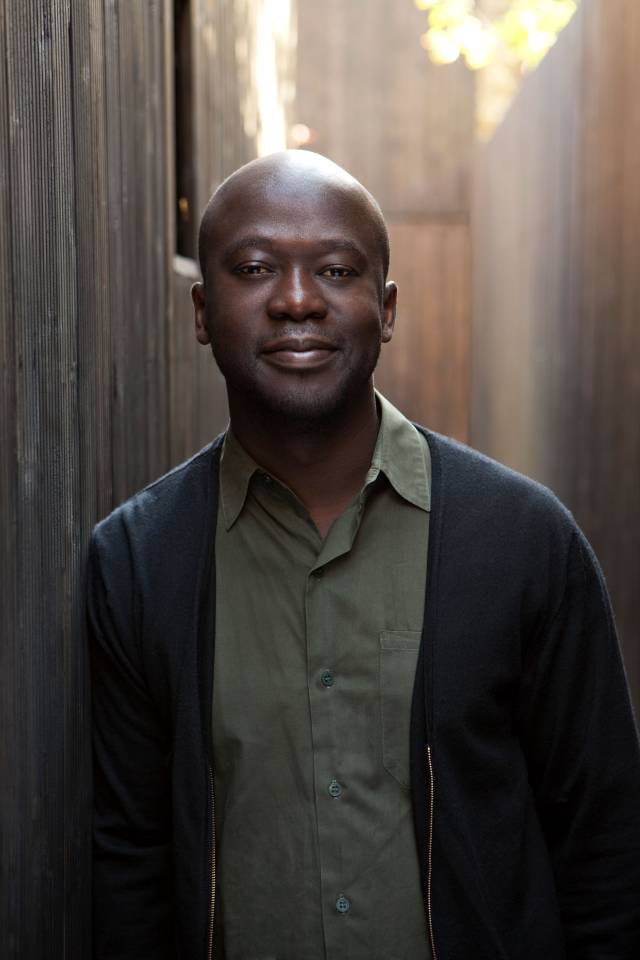
Sir David Adjaye
The renowned architect Sir David Adjaye, along with colleagues from Adjaye Associates and Cooper Robertson, has produced an exciting design concept for the Museum that will heighten its visibility, expand the range of works that it can display, and invite participatory engagement from our campus and the surrounding community. The project will create dramatically better space for the Museum and the Department of Art and Archaeology. It will also preserve and integrate the highly successful Marquand Library. The main museum building will have to close at the end of January 2021 to prepare for the impending project. During the construction period, the Museum will curate exhibitions elsewhere on campus and at Bainbridge House, a lovely and historic Art Museum space now open on Nassau Street.
Ennead Architects are assisting us with the planning for an ambitious set of projects to be built along Ivy Lane and Western Way north of the football stadium. They will include a new home for the environmental sciences, which are now located in Guyot and Eno Halls, and a suite of engineering buildings, including a new institute in bioengineering. We expect construction of the environmental studies building and the bioengineering project to begin in early 2022. After the Department of Geosciences and the Department of Ecology and Evolutionary Biology move to Ivy Lane, we will renovate and expand Guyot Hall and rechristen it as Eric and Wendy Schmidt Hall, which will house the Department of Computer Science.
Thanks to funding requested from the federal government and a contribution from the University, the Princeton Plasma Physics Laboratory is also constructing a new building, the first at the Laboratory in more than 25 years. When the Board of Trustees updated the University’s strategic framework last June, it called out the importance of the Laboratory and encouraged the University “to explore possibilities for increasing the connections between the University and the Laboratory in ways that advance the missions of both organizations.” With leadership from the Laboratory’s director, Sir Steven Cowley *85, and the vice president for the Plasma Physics Laboratory, David McComas, these efforts are moving forward and attracting enthusiastic support. I am grateful to the Department of Energy, and to members of Congress, for enabling and encouraging the Laboratory to move in these exciting new directions.
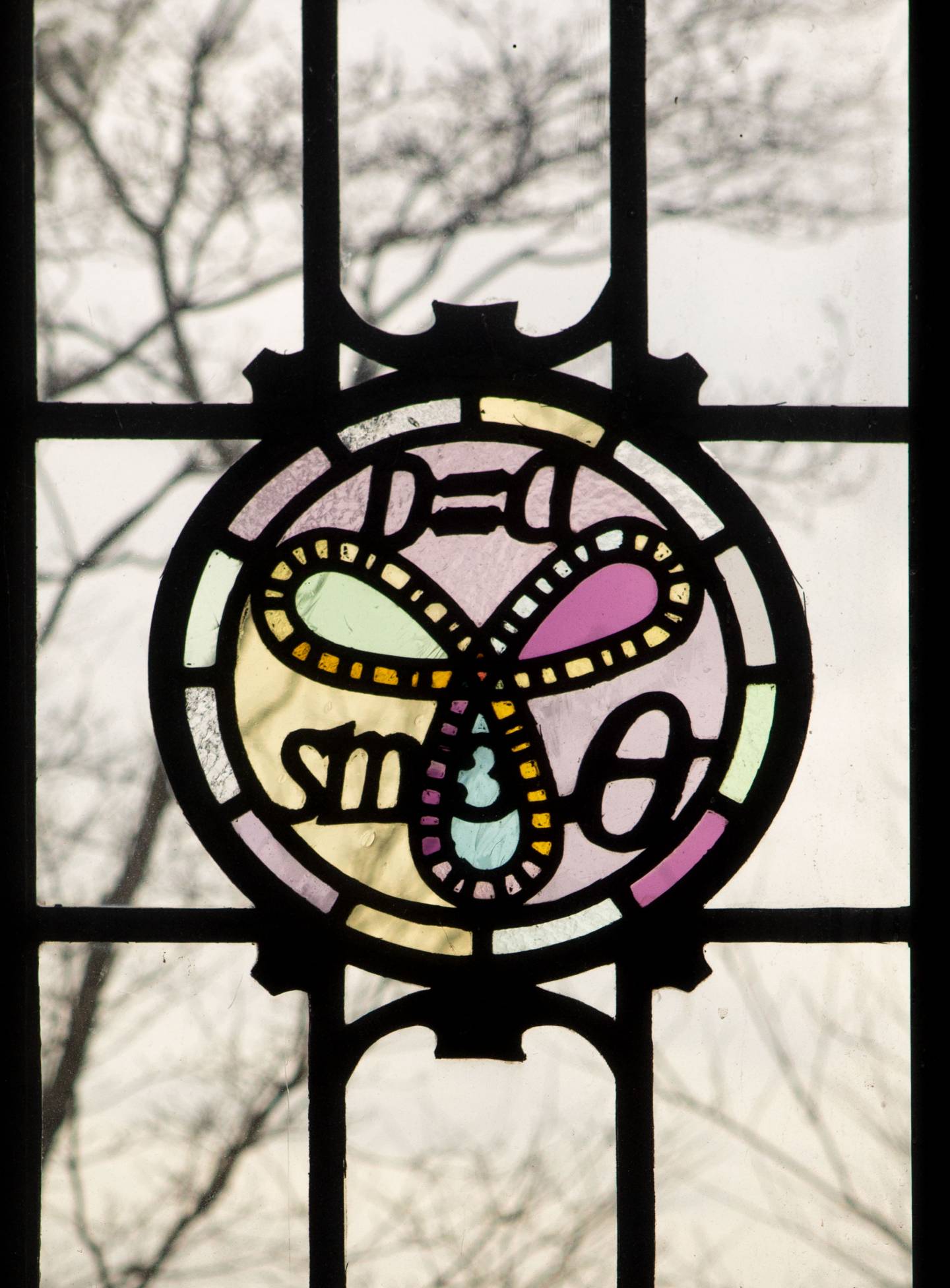
Under Veblen’s guidance, mathematical details permeated Fine Hall (now Jones Hall), including equations and graphs set into leaded glass windows. This one shows the three-petal rose graph of ρ=a*sin(3θ), in polar coordinates.
As I hope this brief summary makes clear, we are heading into an unusually intense and sustained period of construction on the campus. These projects will both enhance our campus and amplify the power of our tremendously talented community of scholars. The belt of projects running from Ivy Lane on through Guyot, Eno, and Wilson College will give new purpose and coherence to that area of campus. Most importantly, the new buildings will aim to stimulate the kind of creativity and engagement that are essential to Princeton’s mission and that were on Oswald Veblen’s mind when he planned Fine Hall, and shaped this University’s future so profoundly, ninety years ago.
The original Fine Hall now bears the name of Thomas D. Jones 1876 and his niece, Gwethalyn Jones, the donors who made possible its construction. As was the case when it constructed that building, Princeton’s ability to carry out the projects that I have described will depend on the support of generous friends and alumni. For the last several years, Princeton has been in the “quiet phase” of a campaign to support the priorities identified in its strategic framework. I am pleased that we have already raised a substantial amount of the support needed for our capital plan, including gifts from Ronald O. Perelman and Debra G. Perelman ’96 to name Perelman College and from Eric Schmidt ’76 and Wendy Schmidt to name Eric and Wendy Schmidt Hall, the future home for computer science. I look forward to sharing news of additional gifts as we approach the public launch of our fundraising campaign next fall.
That campaign will focus on the mission and values that define this University: scholarship, research, teaching, service, access, and inclusivity. Talented people, and the impact they bring, are the core of that mission, an observation that suggests one final lesson from Oswald Veblen’s remarkable story. Veblen probably did as much as anyone to reform and improve this University. His achievements illustrate how the stands we take and the investments we make today can shape the University for decades to come.
Yet, Oswald Veblen never held a title like “president” or “dean” while he was at Princeton. He was a faculty member with tremendous vision and constructive energy. That is very much the soul of this place: Princeton excels because of its spectacular faculty, staff, students, alumni, and friends, and because of the bonds that knit them together into a scholarly community.
Those bonds were evident in the steadfast, caring, and deeply moving efforts of so many students, staff, and faculty to support our graduate student, Xiyue Wang, during his long, unjust imprisonment in Iran. I am delighted that Xiyue has been reunited with his family and our community, and I am grateful to all of you who participated in the efforts on his behalf, and, indeed, to all of you who make this University such a special place in so many ways. I look forward to working with you to make it even better and to promote world-class teaching and research about today’s deepest questions and most urgent challenges.

